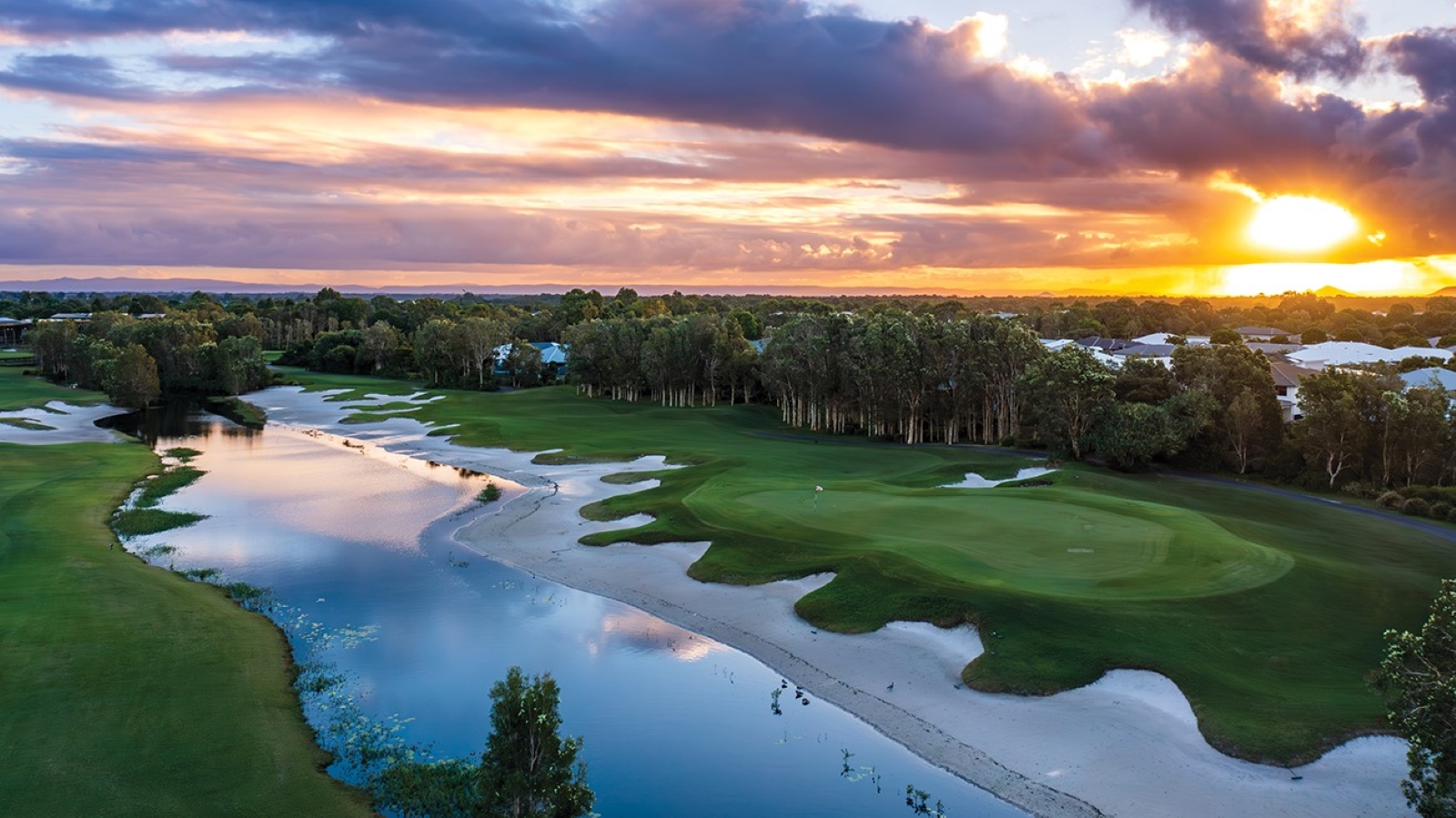South East Queensland experienced another wet start to the year with near record rainfall and flooding. This proved to be a major blow to golf courses across the region. Many were hoping for some rain in the final months of 2023 but were then left inundated after Christmas and for the next four months. As the old saying goes… “it never rains, it pours”.
Only a few golf courses between the Sunshine Coast and the New South Wales border were completely spared from the effects of the rains. However, some recovered more quickly and have since returned to normal playing conditions.
Pacific Harbour Golf and Country Club is one such course where, despite nearly 1100mm of rain between January and mid-April, it’s all back to business as usual. This is thanks to what lies beneath the course’s crumpled fairways.
The course is located 70 minutes drive north of Brisbane’s central business district on Bribie Island, one of almost 360 islands in Moreton Bay that have a seemingly endless profile of fast-draining fine sand.

The 137 m long 7th hole is a tribute to the famous 17th island green of the TPC Sawgrass. PHOTO: Brendan James.
When I visited Pacific Harbour to write this course review, the course was in great shape, less than 48 hours after yet another bout of heavy rain. In particular, TifEagle’s putting surfaces – while understandably a little soft – were in great shape and healthier than I’d experienced on my two previous visits since the pandemic.
While the quality of the course has clearly benefited from having plenty of sand underfoot since it opened in 2006, it was during the construction phase of the layout where that sand was the real star of the whole thing.
A golf course architect is happiest with a blank canvas of sandy soil that he can carefully transform into a spectacular layout. And that is exactly what course designer Ross Watson found when he first laid eyes on the relatively flat and sandy landscape that is now home to the Pacific Harbour layout and a huge residential development.

The dogleg right, par 4, hole 5, is 359 m long and features a fairway bunker on the inside corner of the hole. PHOTO: Brendan James.
“Who doesn’t like playing with sand?” laughed Watson, speaking of the early days of development.
“I’ve been lucky enough to build some courses on spectacular sandy terrain, which allows you to be really creative without having to move heaven and earth. I’m really pleased with the end product at Pacific Harbour.
“I tried to create 18 individual and memorable holes that are enjoyable for all golfers. The fairways are generously wide, but there is definitely a variety of lines of play on most holes that require different strategies, and there are many safe hitting areas for less skilled players.”

Along the way you will be observed by numerous wild animals. PHOTO: Brendan James.
And that is the dilemma of every course designer: They have to challenge better golfers without scaring away the masses of golfers, from the casual golfer to the mid- and high-handicap player.
It’s a fine line to walk, but experienced architects like Watson have proven it can be done, as you’ll see at Pacific Harbour.
Watson’s course presents a real challenge for better players, which are undoubtedly the same players who can hit a ball of decent distance. Longer hitters can hit their driver at will as the fairways are mostly generously wide. However, the further you hit your drive on some holes, the more complicated your approach becomes as Watson’s simple, undulating fairway design brings smaller, more precise players back into play.
The width of the fairways and the angled – and sometimes oddly shaped – greens contribute significantly to the risk-and-reward strategy required on most holes.

The course designer Ross Watson was always very careful to keep the impact on the surrounding nature as low as possible. PHOTO: Brendan James.
An early example of this can be found on the short par-4 2nd hole, known as Mahogany. The 307m, slightly left-curving hole is flanked by a lake on the left, while a large fairway bunker is easily reached from the tee on the right. The wide green is protected by a large bunker system on the left and right and is best avoided, particularly when the flag is on the right half of the putting surface. The key here is accuracy off the tee and you should guide your tee shot past the fairway bunker to get a short iron into the green. Long-hitting players tempted to hit their ball close to the green will need to be both accurate and powerful if they are to avoid the dense tree cover to the right and water to the left.
Similar questions arise at the par-4, dogleg right hole 5, which is 359m long and has a fairway bunker on the inside corner of the hole. Although the driving zone is quite wide, your tee shot should ideally flirt with the sand and end up near the right edge of the fairway to have the shortest and most direct approach shot to the kidney-shaped green, which almost wraps around a large greenside bunker and slopes significantly towards the front right entrance.
Watson’s design offers some really strong two-shots – long and challenging in terms of pure ball striking. Even the short par-4s are challenging but also a lot of fun. All offer their own different challenges, but a common denominator is the need to hit quality shots from uneven lies. Again, Pacific Harbour’s sandy subsoil allowed Watson and the builders to shape the clay soil into a far more interesting, rugged and dramatic terrain.

Course architects love being given a blank canvas of sandy terrain on which to carefully design a spectacular layout. PHOTO: Brendan James.
There are great examples of this design all over the course, but perhaps the best waits until the 400-yard par 4 18th hole, aptly named Crown and Glory. The fairway rises and falls like a rolling ocean swell as it winds past a huge fairway bunker on the right. Even further to the right, the lake follows the edge of the hole all the way to the green, which sits just over a metre above the waterline. There is also a deep bunker on the back of the diagonal green. Most players will be faced with a mid or long iron second shot to this green, and they will likely have to make this shot from an uneven lie. You just have to hope the ball doesn’t land under your feet (right-handed players), as this would encourage a lopsided shot towards the water.
While Pacific Harbour’s long holes are a lot of fun, it’s the collection of par 3s that will long be remembered by most golfers.
All four one-shotters in Pacific Harbour are very different from each other, which is an essential aspect of each unforgettable course and a true trademark of each Ross Watson design.
The 4th hole, known as Emu’s Rest, plays 161 m over relatively flat terrain to a huge green with a wide entrance, but has many bunkers on the left and a lonely sand hazard on the right.
The 137-yard 7th hole pays homage to the famous island green of the 17th hole at TPC Sawgrass, and even bears the name of the site of the PGA Tour’s Players Championship. Watson’s version is just a peninsula-like putting surface, but you’d swear it’s completely surrounded by water when you look into the water from the back tee. There’s nothing but a water hazard between you and the edge of the green, which sits nearly six feet above the waterline. The aggressive play is to use the water and drive the shot all the way through, but if you hit too much club, the large bunker through the green can come into play.

The Pacific Harbour is surrounded by a huge residential area. PHOTO: Brendan James.
Watson has always been keen to minimise its impact on the surrounding natural environment and its par-3 13th hole, known as Kakadu, is a great example of this. The 132m hole runs along the edge of some beautiful wetlands and has been designed to be played in a prevailing breeze to challenge your club selection skills.
Perhaps the most talked about hole at Pacific Harbour is the 189m 17th, which extends to over 200m from the tees. The hole features the longest bunker in the Southern Hemisphere, which forms a beach barrier between the fairway/green and a huge lake that runs the length of the right side of the hole. The hole – aptly named “The Beach” – requires a powerful drive into the middle of the slightly elevated green. From the front markers, the task is less demanding, but a minimum 150m tee shot is required to clear the edge of the sand and onto the front edge of the putting surface.
Watson’s design is always fun and challenging. It has been in use for almost two decades now and has evolved significantly from the island-links style of the course since it opened. The surrounding residential areas have settled around the edges of the course and the trees that were planted during construction to create a green barrier between the holes and the homes have definitely settled into their surroundings.
FACT SHEET
LOCATION: Avon Ave., Banksia Beach, Bribie Island, Queensland.
CONTACT: (07) 3410 4001.
WEBSITE: www.pacificharbourgolf.com.au
DESIGNERS: Retrieved 2006-06-06.
COURSE LEADER: Matt Hartup.
PLAYING AREAS: Bermuda TifEagle (greens); Wintergreen Couch (fairways).
GREEN FEES: $89 (18 holes including cart, weekdays); $99 (weekends and holidays).
FACILITIES: The water driving range is open seven days a week. Shanx Mini Golf is fun for the whole family.
MEMBERSHIPS: Pacific Harbour offers a range of membership options to suit everyone, from the individual golfer to the family golfer and non-golfer. Full membership costs $3,165 and offers full access to the club’s facilities and playing rights seven days a week. Full membership includes full use of the country club’s facilities including the pools, steam room, spa, tennis courts and BBQ area, as well as a long list of inclusions.
AWARDS: Rank No. 34 in The Golf Australia Magazine Top 100 public access courses for 2023.




